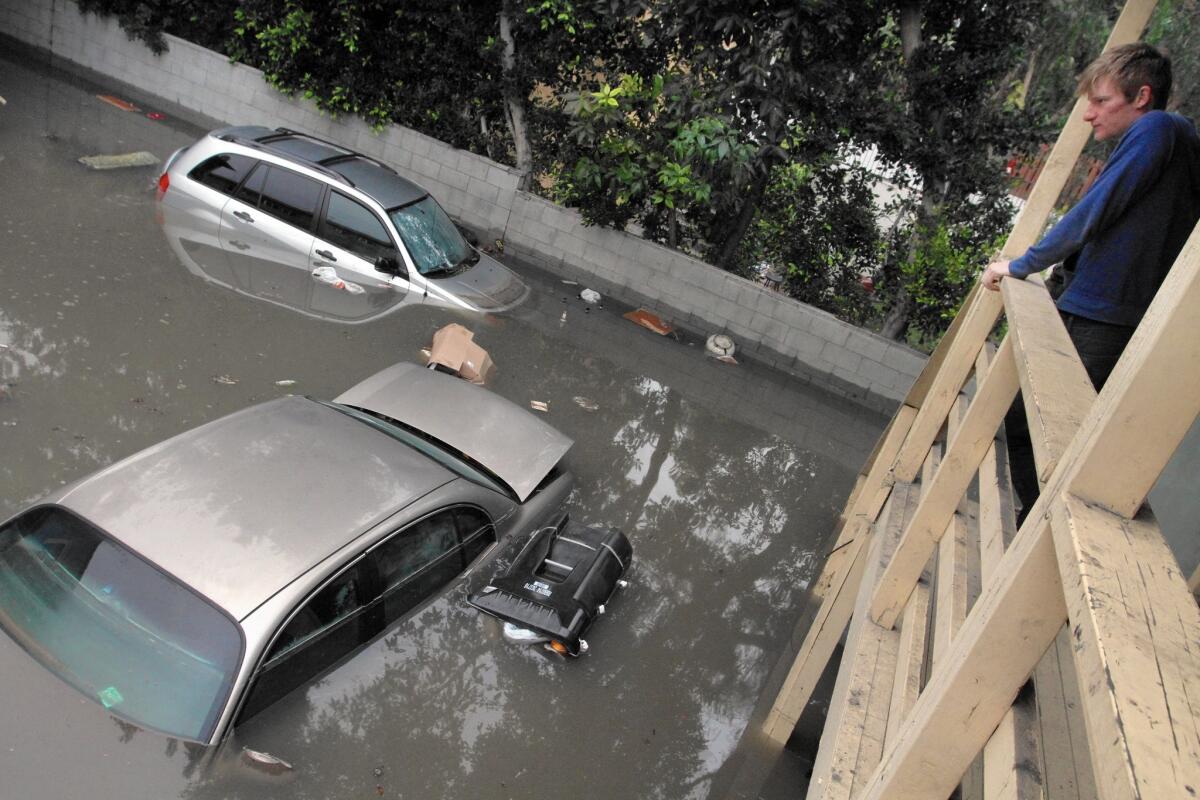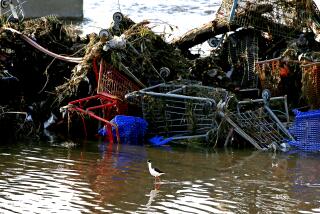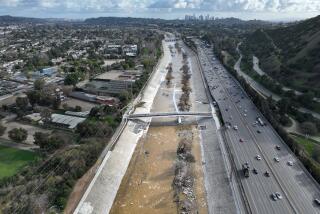Under more pressure in hilly areas, old water mains prone to breaks

A pipe that burst near Franklin Avenue in the Hollywood Hills early Wednesday submerged cars and stunned residents who went without service for hours as torrents of water flooded streets.
A Times analysis of Los Angeles Department of Water and Power data found that hillside neighborhoods like this are particularly susceptible to pipe breaks. In fact, these communities, including Woodland Hills, Silver Lake and Beverly Crest, account for more than a third of the leaks in the agency’s 6,730-mile water main network in the last five years, the analysis found.
The area around the pipe that broke on Wednesday — spewing at least 100,000 gallons of water — has recorded 135 main breaks during the same period, making it the fourth-worst in the city for leaks.
Experts said there is a basic reason why hilly areas have more leaks. Getting water uphill requires more pressure. Water agencies use pumping stations to move water uphill to reservoirs that rely on gravity for downward pressure. That force places greater stress on pipes and can lead to breaks.
Pipes in older neighborhoods such as the Hollywood Hills are also more prone to fail because of their age.
“You have other areas just as old that are not behaving as badly,” said Lucio Soibelman, a civil engineering professor at USC. “It’s the varied pressure of the hills, combined with the age of pipes, that are really driving those breaks.”
The DWP does not record the water pressure of individual pipes, so the cause of breaks often cannot be fully pinpointed. But several destructive gushers have occurred in hillside areas, including a 2009 burst in Studio City that damaged homes and businesses.
INVESTIGATION: Is your street at risk from L.A.’s aging water mains?
The cast-iron pipe that broke Wednesday morning was installed in 1926 and hadn’t had a leak in the last 10 years, said Marty Adams, the DWP’s water systems director. The pipe had a C grade from DWP engineers, who assign letter grades to pipes that indicate priority for replacement.
About 6% of pipes in the system have grades of D and F, denoting the most urgent need.
Utility officials hope to replace 435 miles of pipes with D and F grades over the next 10 years, but doing so will cost about $1.3 billion, and it is not clear where the funding will come from, The Times reported this week.
About one-fifth of Los Angeles’ water mains were installed before 1931. That small fraction of the network accounts for close to half of the city’s leaky pipes, The Times analysis found.
Leaky pipes in the Hollywood Hills are, on average, 10 years older than the rest of the city’s leaky pipes. About 70% were installed before 1931. By comparison, about half of the leaky pipes in other parts of L.A. are that old.
By Wednesday afternoon, DWP crews were excavating the area around the Hollywood Hills leak, preparing to remove and replace about 15 feet of pipe. DWP spokesman Albert Rodriguez said the pipe had ruptured along its seam, but it was not immediately clear what caused the leak. Rodriguez said road repairs were unlikely to begin until Thursday morning.
Many of the neighborhood’s pipes are small, made of steel and located on narrow, steep streets, said Joe Castruita, the LADWP’s director of water distribution. Those pipes often develop tiny holes or small splits that cause relatively little harm, he said.
Steel pipes accounted for 75% of the leaks in the Hollywood Hills and Hollywood Hills West, The Times analysis shows. In the rest of the city, steel pipes accounted for less than 10% of the breaks, while cast iron pipes accounted for more than 80%.
The pipe that burst Wednesday was 18 inches in diameter, a larger water main for the area, and “a backbone line,” Castruita said. Pipes of that size “will do substantial damage,” he added.
The DWP received reports of the leak about 2:30 a.m. Wednesday, spokeswoman Michelle Figueroa said. About 100 customers were without water service throughout the day as crews taped off the affected block of Dix Street, cleared debris and worked to shut off the water. The rushing water sliced a 10-foot crack into the asphalt and left a trail of rocks in its wake.
Los Angeles police alerted residents, who hurried to move their cars to drier ground. At least four cars parked in an underground garage were completely submerged, DWP officials said.
Miller Lee rushed to the scene after he saw the apartments his father owns on the news. At least eight people live in the four units above the flooded garage, he said.
Lee estimated that the water caused more than $100,000 in damage to the garage alone. For nearly 30 years, his family stored classic cars, antique Italian furniture and pricey Persian rugs inside.
“The water wrecked it all,” Lee said. “I’m devastated. I feel bad for our tenants.”
“Our hearts go out to folks with any kind of property damage,” the DWP’s Adams said. “We realize it’s a huge inconvenience.”
Adams said the agency has done a good job identifying at-risk pipes and replacing them. “There will never be a time there are zero leaks,” he said, while reiterating that the department will soon argue for a rate increase to help fund pipe replacement.
“What we don’t want to do is get behind the curve,” Adams said.
Erik Sanjurjo, the public safety chairman of the Hollywood United Neighborhood Council, said the DWP’s water operation has been underfunded and that he would probably support a “long overdue” rate increase.
Residents of the hills have become accustomed to inconvenience, he said — including mudslides, decrepit roads and pipe leaks.
“We’re used to this, unfortunately,” Sanjurjo said. “This is a very beautiful place to live but it’s also a very fragile ecosystem.”
Times staff writer Veronica Rocha contributed to this report.
More to Read
Sign up for Essential California
The most important California stories and recommendations in your inbox every morning.
You may occasionally receive promotional content from the Los Angeles Times.













